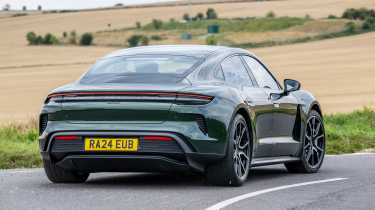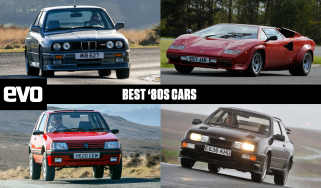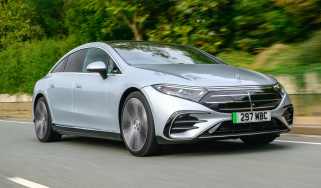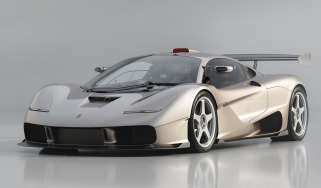Porsche Taycan – ride and handling
There’s impressive depth to the steering and chassis, and Porsche’s Active Ride tech can be freakish
Rather than the performance, it’s the Taycan’s uncanny precision and accuracy that steals the show. There’s genuine Porsche DNA in everything it does, making it one of the most satisfying EVs to drive of them all.
When fitted with rear-axle steering, its responses are crisp and beautifully measured, allowing you to commit into an apex with one clean sweep of the wheel. The steering is perhaps a touch too heavy when loaded up but this gives a good sense of the forces transmitted through the tyres, and there’s even a hint of granular feel coming through the rim. The brakes don't feel as immediately intuitive, however; the pedal is light and springy initially and firms up once the friction brakes start to blend with the regen, so brushing off speed going into corners requires careful modulation.
Take liberties with the Taycan – all 2090kg of it (in its lightest form) – and it really starts to impress. The facelift introduces Porsche’s Active Ride tech that first appeared on the Panamera, which enables precise control of suspension forces at each corner of the car. It’s not a cheap option at £6291, but it’s very clever, doing away with conventional anti-roll bars and using electro-hydraulic pumps to regulate flow inside the dampers to compensate for pitch and roll. As a result, the body is extremely well supported and you don’t need to slow down your inputs to allow the weight to settle, which feels a bit alien in such a heavy car. The Taycan doesn’t feel light per se – you’re still conscious of the enormous forces the tyres are dealing with – but Active Ride makes use of all four contact patches by distributing the loads evenly across them, no matter what you throw at it. The (now standard) air suspension setup is impressively poised and flat to begin with, and Active Ride accentuates these qualities.
More reviews
In-depth reviews
Review
Reviews
Does this translate into a more entertaining driving experience? In some ways, yes. It gives you more confidence and encourages you to dig deeper into the Taycan’s abilities. But it does mean that the Taycan can feel slightly clinical in the way it picks apart a road, and it doesn’t offer as much gratification as Hyundai’s Ioniq 5 N with its more interactive driving experience and greater sense of fun. You need to work the Taycan hard – really hard – for it to feel alive. Reach the limit of the Goodyear Eagle F1s and the chassis feels stable and neutral; you get either a nibble of front-end push or a quick twist of oversteer, and while the Taycan does break away tidily, this feels like a by-product of provocation rather than a natural part of the cornering process.
Admittedly, this won’t matter to most owners. For them, the fact that the Taycan is now better able to lean into its role as a long-distance electric GT will be more valuable. As well as the extra control, the Active Ride system allows the Taycan to flatten large bumps like a luxury saloon, and it wafts along more smoothly – and more quietly – than before. Where the new suspension isn't as effective is over broken surfaces and high-frequency bumps, which still resonate and vibrate through to the cabin. Switching to the softest damper setting introduces a touch of vertical movement at speed but doesn’t filter out this brittleness, and Sport mode feels like a better compromise.
The Cross Turismo rides 20mm higher than the saloon and Sport Turismo, but the Active Ride tech means that body movements are still tightly controlled in the firmer damper settings. In the softest mode you do get a slight sense of the higher centre of mass, but by-and-large, the saloon's sharpness, consistency of response and precision are all there.




